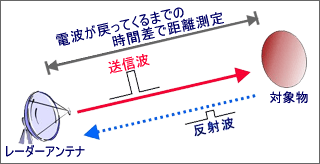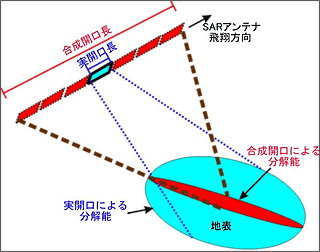"What is InSAR?"
Principle of InSAR / Elementary course
The SAR interferometry is based on the SAR technology. The acronym SAR stands for Synthetic Aperture Radar.
A radar is a familiar word such as a weather radar, but many people will have no idea what synthetic aperture is. Because SAR is based on the radar technology, we outline the radar itself first.
Synthetic Aperture? Radar
The radar transmits a radio wave from a satellite antenna and receives a reflected wave from a target.
The amplitude of the reflected wave can be used to characterize the size and the surface material of the target.
We can also make a rough estimate of the distance between the target and the satellite by measuring the time the wave has bounced back to the satellite.

Figure 1. Principle of radar
In the case of a radar observation, the point is the resolution. To obtain high resolution we need to transmit a narrow beam by reducing a beam width, but the size of an antenna must be large to obtain greater directivity. If the radar which actually transmits a radio wave from a satellite has the antenna directivity required to obtain the resolution more than 10m on the ground, the size of an antenna, which is called "aperture", becomes more than 1km and is impractical to install on a satellite.
So, there is a technology which artificially "synthesizes" an "aperture" using a flying object (satellites or airplanes) that transmits and receives a radio wave during flight in order to obtain an image equivalent to one acquired by an antenna with a big aperture size. It is called "synthetic aperture radar".
As shown in Figure2, even if the antenna whose aperture size is actually small is used, the resolution in the direction of a fright track is improved by the synthetic aperture technology which makes up a virtual antenna with a big aperture size by transmitting and receiving radio waves during flight.

Figure 2. Resolution improvement by the synthetic aperture technology
* The larger aperture size is, the higher directivity!
However, we cannot improve the resolution of the direction orthogonal to a flight track only by using the synthetic aperture technology. In Figure 2 above, the resolution of the orthogonal direction remains at a low level.
The resolution of the orthogonal direction depends on a range resolution between an antenna and a target. What will make this range resolution improved, then? The answer to this is to make a pulse width of a transmitting wave as narrow as possible. However if we make the pulse width narrow, a receiving wave is noisy because an average power of a transmitting wave becomes small. Then, using a pulse compression technology we make the superficial pulse width of a transmitting wave narrow with large transmitting power.
Using these two technologies, the synthetic aperture and pulse compression technology, we can measure the amplitude, etc. of a reflected wave for each point (pixel, typically square a few meters on a side) in the mesh grid made up on the ground.